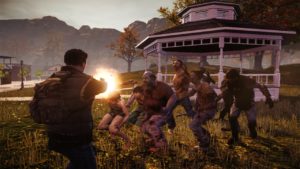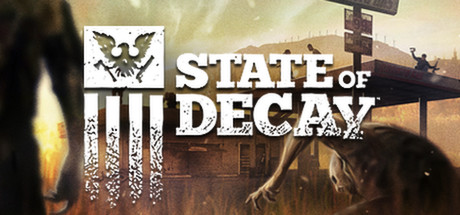I apologize for the long hiatus of my reviews. Life has been very busy, and I found myself playing more Dwarf Fortress after I wrote my review of it, meaning that I did not really pick up any new games to review for a while. What finally motivated me to purchase a new game was the high praise given on the Gamers with Jobs podcast to State of Decay, a game that seemed to come out of nowhere to become the Xbox 360’s counterpart to the PS3 exclusive and highly acclaimed post-apocalyptic survival game The Last of Us. In some ways, you could view these two games as counterparts, both attempting to fill the niche of survival games that have recently regained popularity among mainstream gamers. However, each game is entirely unique with its own creative gameplay mechanics. I hope to review The Last of Us soon, but for now I will be writing on State of Decay, which deserves equal attention from my point of view.
Even though
Undead Labs, the developer of
State of Decay, announced that it will be releasing the game to Steam at some point in the future, I did a very uncharacteristic thing and bought it on the Xbox Live Arcade. After dusting off my Xbox and applying the 5-6 system updates that came out since the last time I used it, I loaded up the game. As it was only $20, I was expecting a rather underwhelming graphical experience with one or two unique mechanics that made it unique. However, throughout my playthrough, I was continually amazed that this game was not released as a $60 AAA title. The graphics are not the best I’ve seen, but they’re not too shabby. It’s really about comparable to GTA 4. The game also includes an intriguing story where you learn more about the zombie outbreak and you unlock new zones of the map.
Where the game really shines, however, is the sandbox style base management and map-wide zombie outbreak simulation. Although the story is fun to follow, in my opinion, it is much more fun to delay the story as you attempt to find more resources, build more facilities at your base, and (a favorite of mine) collect all the cars you can find at your base. As you progress, dynamic missions will also pop up, such as hunts for certain types of special zombies or finding a lost member of your survivor community. Although these dynamic missions can become repetitive, they do ensure that there is always something to do and force you to balance the possible outcomes of choosing not to help a friend (sometimes they survive, and sometimes they don’t) in order to make a supply run or of clearing out an infestation to make your base more secure instead of finding more ammo. These choices, and how quickly you are forced to make them, really enrich the survival mechanics of the game.
- Graphics/Visual Effects 6
As I mentioned earlier, the graphics are quite impressive for a $20 game. However, they are not really to the level of most games being released today. The most direct comparison must be made with The Last of Us, of course, and here there is a clear difference; however, it should be noted that State of Decay is simultaneously simulating a lot more information than The Last of Us‘s more episodic approach. The game is constantly processing information about the entire map, a pretty large one at that, which draws RAM and processor speed away from rendering outstanding graphics. Because of this load on the system, it is quite common to encounter periods of low frame rates while playing State of Decay, especially while driving cars at high speeds. These periods were only a minor annoyance though, and I never encountered low frame rates while I was actually fighting zombies or doing some other where frame rate is a matter of life and death.
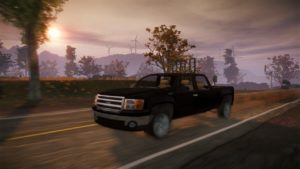 |
| Frame rates generally drop when you drive at high speeds, but as long as you stay on the road, it won’t be a problem, and as soon as you slow down the FPS will normalize. |
- Story Content 8
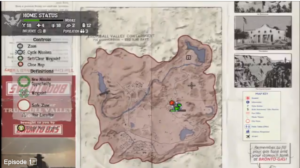 |
| Trumball Valley is a fairly large area. Story missions pop up as green waypoints on the map. |
The story of State of Decay draws you into the world of Trumball Valley. It progresses in a similar fashion to Grand Theft Auto 4 and Red Dead Redemption in that story missions appear on your map and you begin them by traveling to a particular point. However, there are also stories in the background of your survivor community that appear through becoming friends with particular people, helping out other survivor communities, and (in some cases) by the deaths of some survivors. Each person in the world has a unique personality and life story that may or may not come out as you play through the game.
What works about the story is that it withholds crucial bits of information at each step of your investigation into what is causing the zombie outbreak. It follows this “cliffhanger” approach all the way through, making you want to keep playing to find out what happens next.
- Story Pacing 10
The story’s pacing seemed really great to me because it progresses only as fast as you would like it to go. Although you will get annoying messages from NPC’s to try to get you back on the story missions, I don’t think any of them actually expire, so you could conceivably spend as much time doing random events and building your base as you like. This time of delaying the main story is probably the highlight of the game, which is why Undead Labs have announced that they will be adding a sandbox mode to the game soon.
- Gameplay 10
Gameplay is the highlight of this game and what makes it incredibly unique and fun. Essentially you play as a survivor of a zombie outbreak in Trumball Valley, a fairly rural environment dotted by small towns. While the basic gameplay elements of bashing zombies with a pipe or shooting them in the head with a shotgun are fairly standard (seeming like a spiritual successor to Dead Rising), the really interesting component of gameplay is the ever-changing dynamics of your survivor community.
Although you play as one survivor at a time, you can play as any character in your community whom you have become friends with. This dynamic is to try to simulate your character becoming tired and going home to rest. When you do so, you switch to play as another survivor, who is “taking over” all your missions. Each character has a unique biography that affects what skills they start out with and how easily they can level them up. Skills include such things as cardio (which allows you to run faster for longer), shooting (which makes your character shoot more accurately), and reflexes (which seems to make your character more adept at administering killing blows to zombies).
 |
| Each character in State of Decay is unique and has a bio and set of skills that develop as you use them. |
Of course, there is some risk involved to using your high skill characters for very dangerous missions. If a character dies, they are gone forever (and the game has a constant autosave feature, so you can’t just turn it off to get them back). You then choose another character to play as in the community, and you must adjust to having one fewer member of the group (which affects a wide variety of things, including how well you can survive in particular home sites) and losing your high-skill character. Interestingly, a unique eulogy seems to be said for every member after their death, which makes their death even more disheartening.
Another important aspect of the gameplay is what I would broadly term “base management,” which includes such things as building facilities at your home, setting up outposts to defend yourself from zombie hordes, bringing supplies back home from deserted buildings, and taking on randomly generated missions that increase morale or save community members from dying.
 |
| One of your first base options is an old church. It doesn’t have a lot of facility options but is fairly secure. |
The most basic aspect is building facilities. It works similarly to any base management game, giving you a limited number of spots to build facilities that usually outnumber the number of spots, forcing you to make choices about what bonuses will be most helpful to you. Is it more useful to make a garden to grow a small amount of food each day or a workshop to repair your cars? These are the types of strategic decisions you will have to make as you build your base, and they will affect how you spend your time. For example, if you choose the garden over the workshop, you will need to find more vehicles in the world to bring home, whereas if you choose the workshop, you will need to find more food supplies to bring back home on a more regular basis. Different home sites have different numbers of facility slots and many have “built-in” facilities that come with the site and provide somewhat unique bonuses. Of course, larger sites require a larger amount of construction materials to maintain, so everything you choose has consequences when it comes to setting up your base.
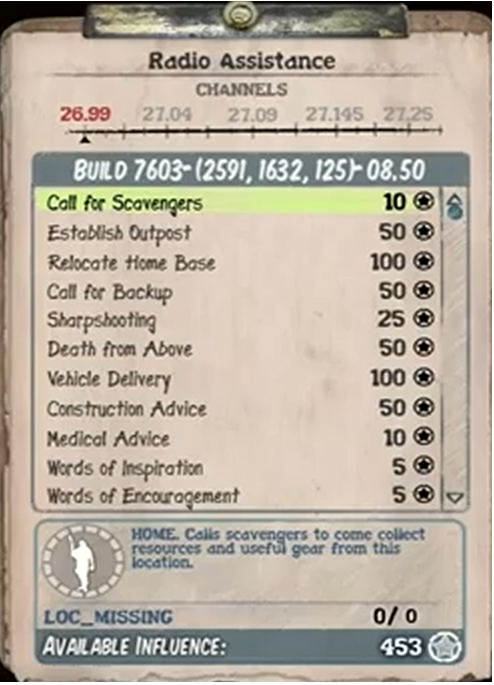 |
| The radio function allows you to call for various forms of assistance from characters you are allied with. This allows you to call for others to pick up supplies or to set up an outpost. |
Outposts are not easy to understand, but they are essentially safe zones that you establish after clearing zombies from an indoor location (they can’t be established outside). They allow you to access your supply locker from a remote location, but these lockers do not allow you drop off supplies (you still need to go home to do that). Outposts prevent zombies from spawning at that location and if you set traps (which costs some resources), the outposts will kill any wandering hordes that enter them. Also, if you set up an outpost in a building that is not fully looted, you will receive a small amount of supplies each day from any known resource at that location. Again, larger bases can support more outposts, so you have to think about this when you think about where you want to set up your home.
 |
| There are different schools of thought about how outposts should be utilized. This particular screenshot shows a large safe zone being created around the player’s base. |
Running supplies consists of entering locations (which might be buildings or outdoor locations like campsites or fields), searching through the different searchable items at that location (they will glow so you know where they are), and then either taking a load of supplies back home yourself or calling in for a fellow survivor to come and loot the location. You have to be careful though because this survivor might encounter trouble on his or her way and you might need to rescue them.
Finally, there are random missions which include clearing out zombie infestations of locations, surveying the surrounding area looking for danger, or rescuing a fellow survivor who is trapped by zombies. These pop up randomly and can become repetitive, but they tend to add some spice and rhythm to your base management.
- User Interface/Controls 7
The controls and UI for this game work, but they are a little difficult to learn. The basic combat mechanic requires you to use the X button for the basic attack, but then hold LB and press Y for a killing blow, which feels very awkward at first. Also, the base management menus are just very complex, which is not necessarily bad but makes them difficult to learn when using an XBox controller. I think that when the Steam version comes out, this menu navigation will be significantly easier on a mouse and keyboard interface; however, the somewhat awkward melee combat rhythm will probably remain the same.
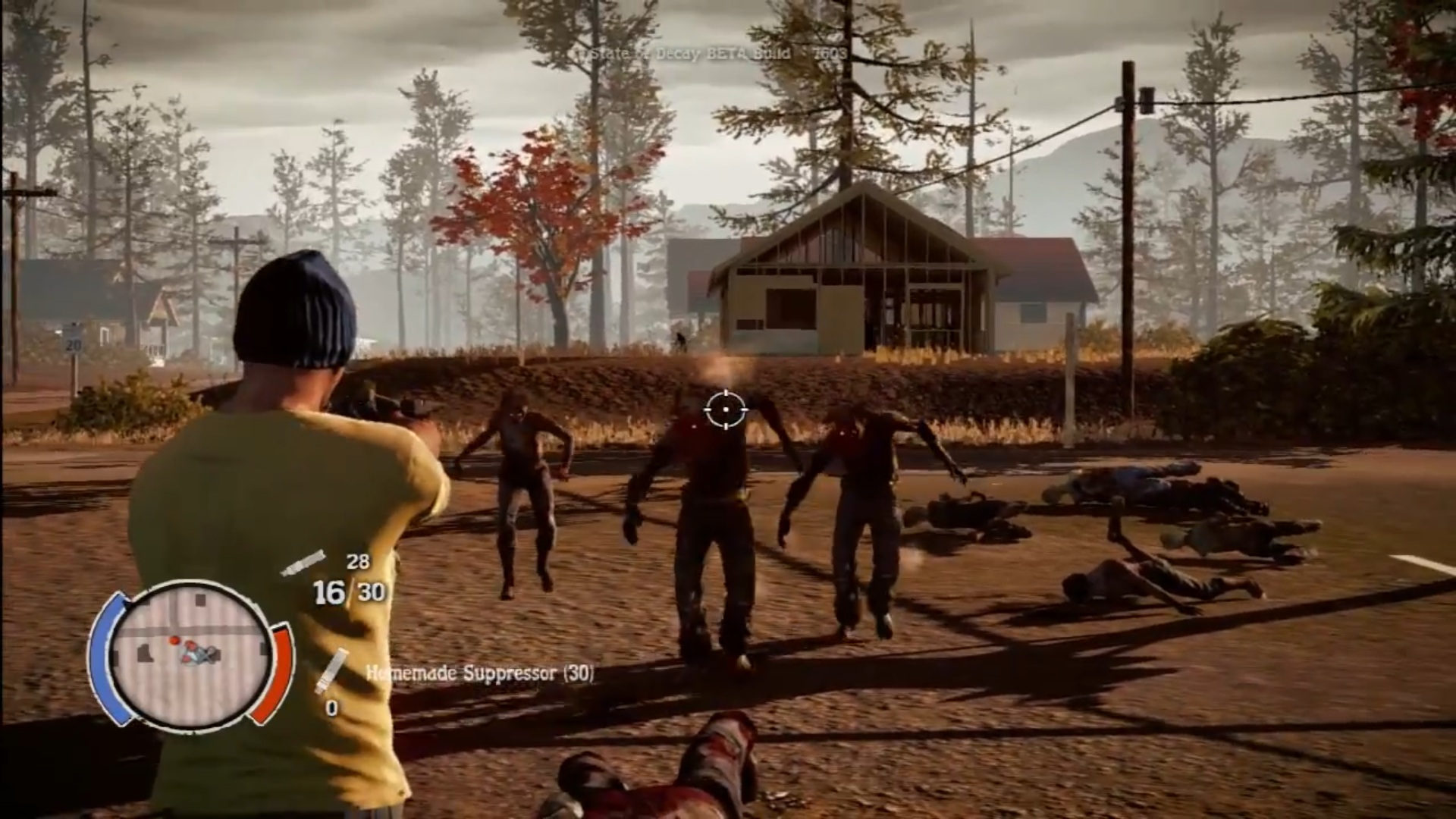 |
| Unlike the melee rhythm, shooting is very intuitive to anyone who has played a shooter this console generation. Holding left trigger brings up the gun and crosshair, and pressing right trigger shoots. However, due to the scarcity of ammo, I found myself using the gun far less than melee weapons. |
- Soundtrack 8
I would say that the soundtrack to this game adds a decent atmosphere and doesn’t seem that repetitive; however, it doesn’t really stand out as a “great” soundtrack to me. It is good, however, and adds to the experience. I especially like the understated piano track that just gives me chills when looking out over the ravaged landscape.
- Replayability 9
This game’s replayability is strong because each game can be played a bit differently. You can choose a different base, make different allies among other survivor communities, and focus on guns if you did melee weapons the first time through. When the sandbox mode is introduced, I think replayability will turn into a 10, but at present the story content will be slightly annoying the 2nd time through and following (but only really a slight annoyance in my opinion).
- Completeness 8
This game feels fairly complete, especially since the developers have patched it recently. The only reason I demote it a few points is because the sandbox mode has not yet come out and we are still waiting for the Steam release. I think the game will feel complete after these improvements.
- Support 10
The developers have been very responsive to fan input, releasing patches quickly and developing the sandbox option purely because it was requested by players. Check out their website for the latest news on the game:
http://undeadlabs.com/.
- Uniqueness 9
Even though the zombie game market has been over-saturated for years, State of Decay does something that no other game in its genre does. It includes strategic elements and a sandbox feel, features that I really did not think could be done well in the zombie apocalypse genre. I think that these new cerebral elements will now be looked for in other similar games. Many gamers who play these games might now feel that a purposeless bloodbath is just not as satisfying. Because of this new take on the entire genre and setting what I think will be a new benchmark for developers programming zombie games, State of Decay deserves a high uniqueness rating. However, I cannot give it a 10 because the actual combat still feels a bit rote. I would have liked to see more options available in how to kill zombies beyond the genre staples: baseball bats, shotguns, and Molotov cocktails.
Intangible: +3
I am giving
State of Decay an extra 3 points simply for its value. At $20 on release day, it is a great deal because it provides roughly the same amount of content I would expect from a $60 title for such a low price. Because of this price point, I have been extremely happy with my purchase and plan to support Undead Labs in the future by buying their products if their business model remains so beneficial to gamers.
Honestly, this game is worth dusting off the XBox 360 to play; I think even people who are not fans of traditional zombie games will find a lot to like in State of Decay.
Final Score: 88
Please follow my blog if you like my review!
I’ve also set up a Twitter account for this blog. Follow me to get the latest updates: https://twitter.com/GameSimply
Also, I am currently freelance. Please contact me if you are a developer or website looking to hire me to review a game.
